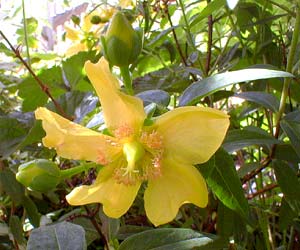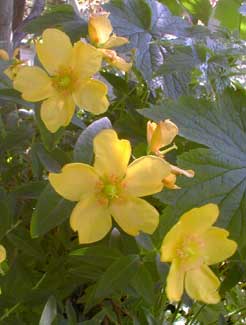
'Hidcote'
Saint John's Wort
"Lo, the herb of healing, when once the herb is known,
Shines in shady woods bright as new-sprung flame."
-George Meredith,
1828-1909
1828-1909
The cultivation history of Hypericum 'Hidcote' is lost to time. It was formerly called H. patulum 'Hidcote.' It is now believed to be a hybrid of the large asiatic H. cyathiflorum 'Gold Cup' crossed with wild H. calycinum a smaller, creeping, gorgeously-flowering long-stamened Aaron's Beard native from Bulgaria to Turkey.
In very temperate zones such as ours, it can grow to a six by six feet, making it one of the larger varieties of St. John's Wort. But it is easily kept more compact & in the three by four foot range if pruned late each winter to remove all old wood. This will keep it from getting leggy & will promote the new twig growth on which it blooms.
It will be vastly more floriferous with pre-spring pruning to induce rapid new twig development. When grown in golder zones, it is not an evergreen, & won't grow quite so large. It will need to be cut nearly to the ground from winter damage & die-back. But since it blooms on new growth anyway, die-back is not injurious, & it remains an excellent flowery subshrub for late spring on through to autumn.
 'Hidcote' has much larger bright yellow flowers than our H. moseranum hybrid cultivars, which are comparative dwarves. The pure yellow five-petalled blossoms are three inches wide with a crown of furry stamens circling the center.
'Hidcote' has much larger bright yellow flowers than our H. moseranum hybrid cultivars, which are comparative dwarves. The pure yellow five-petalled blossoms are three inches wide with a crown of furry stamens circling the center.Though usually recommended for full sun locations, in our experience it gets bushier & greener when grown in partial shade, & seems to bloom just as nicely as when in full sun. Ours at least blooms beautifully in a shade-garden with only dappled sunlight, though the small hybrids near it would undoubtedly bloom better if we could get more sun to those.
'Hidcote's' primary bloom period is very long, June through September or even October; or more precisely, it blooms best June & July, seems to be finished during August, then has another flourish of blossoms for September & October. Better than that, in our zone, in its protected location, it approaches being entirely evergreen & an occasional flower can appear on it almost any time of the year, though it seems finally to rest from blooming & to concentrate on developing new twigs during the early part of spring. Even if not cut back dramatically as it can be at this time, some spring pruning is essential so that the blooms for that year will again be numerous.
Why this genus of subshrub is best known as St. John's Wort is not definitively known, though it is believed that in medieval times the common European & North African species was seasonally gathered from the wild & burned in the belief that the smoke it generated would cast away evil demons & spirits of the dead. It was used as a folk remedy for doomful spirits by hanging it above windows or above images of saints; the genus name means "Above Icons." If a sprig with a yellow flower was placed under one's pillow on St John's Eve, the Baptist would appear to the dreamer & provide a blessing that was proof against death for one year.
Whether this explains the name, or whether the name inpired the superstitions, is a matter of speculation. But many other legends & possibilities gathered around these little shrubs to extend its association with a Christian saint. The Knights of Saint John in the time of the Crusades were said to have sought out whatever species of St. John's Wort could be found growing wild in all the lands of their violent travels, & they used St. John's Wort to treat the injuries of war-wounded.
When the Christian testament says that John lived in the wilderness eating only locusts & wild honey, the Greek word normally translated "locusts" was reintepreted to indicate a plant upon which locusts landed, & this plant which he ate came to be identified with the famed medicinal plant. This legend was best inspired by H. perforatum the flowers of which have reddish spots that can "bleed," with leaves that exude droplets of a toxic oil said to represent tears. Like most species within the genus, H. perforatum is blooming around the time of the beheading of the Baptist, which by tradition is dated as June 24. By their general similarity of appearance species to species, Hypericums from all around the northern hemisphere came to share the name & the legends.
Superstitions have not vanished in the last two hundred years to the present. According to the Doctrine of Signatures which was the original "alternative medicine" crackpot fand, God marked each herb with a clue for its medicinal value. By this Doctrine, because the flowers are yellow, St. John's Wort is to be used for jaundice. Though it has some real medicinal values, treatment of jaundice is not one of them. To this day, it is used for a myriad of purposes that extend quite far beyond what is scientifically likely, despite that what is likely should have been sufficiently useful.